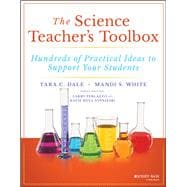A winning educational formula of engaging lessons and powerful strategies for science teachers in numerous classroom settings
The Teacher’s Toolbox series is an innovative, research-based resource providing teachers with instructional strategies for students of all levels and abilities. Each book in the collection focuses on a specific content area. Clear, concise guidance enables teachers to quickly integrate low-prep, high-value lessons and strategies in their middle school and high school classrooms. Every strategy follows a practical, how-to format established by the series editors.
The Science Teacher's Toolbox is a classroom-tested resource offering hundreds of accessible, student-friendly lessons and strategies that can be implemented in a variety of educational settings. Concise chapters fully explain the research basis, necessary technology, Next Generation Science Standards correlation, and implementation of each lesson and strategy.
Favoring a hands-on approach, this bookprovides step-by-step instructions that help teachers to apply their new skills and knowledge in their classrooms immediately. Lessons cover topics such as setting up labs, conducting experiments, using graphs, analyzing data, writing lab reports, incorporating technology, assessing student learning, teaching all-ability students, and much more. This book enables science teachers to:
- Understand how each strategy works in the classroom and avoid common mistakes
- Promote culturally responsive classrooms
- Activate and enhance prior knowledge
- Bring fresh and engaging activities into the classroom and the science lab
Written by respected authors and educators, The Science Teacher's Toolbox: Hundreds of Practical Ideas to Support Your Students is an invaluable aid for upper elementary, middle school, and high school science educators as well those in teacher education programs and staff development professionals.








